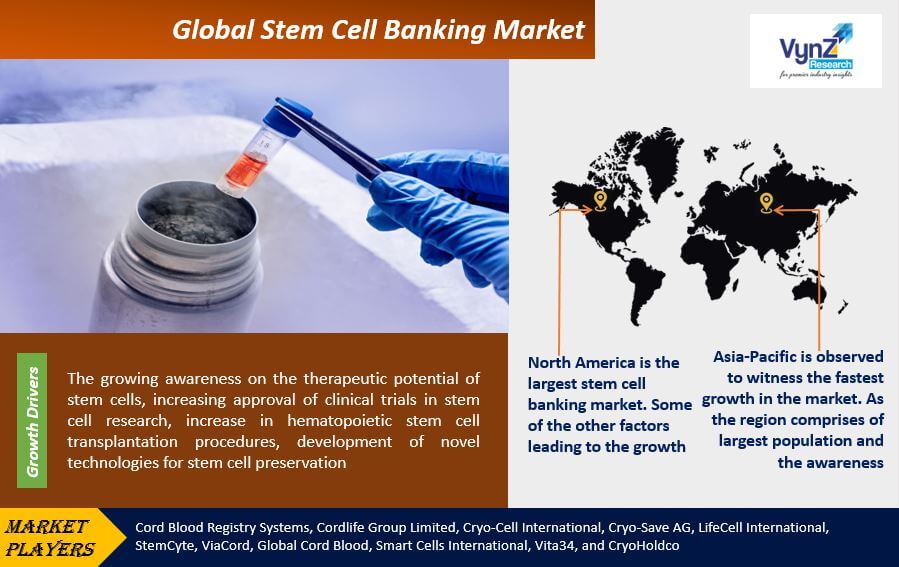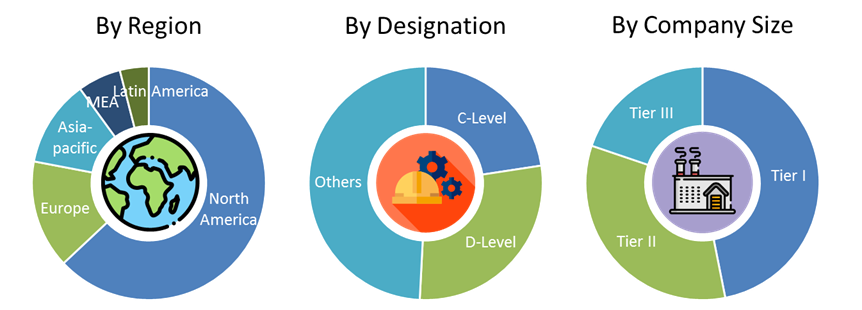Global Stem Cell Banking Market – Analysis and Forecast (2025-2030)
Industry Insights by Source (Placental, Adipose Tissue-Derived, Bone Marrow-Derived, Human Embryo-Derived, Dental Pulp-Derived, and Other), by Service Type (Sample Preservation and Storage, Sample Analysis, Sample Processing, Sample Collection and Transportation), by Application (Personalized Banking, Clinical and Research), and by Geography (U.S., Canada, Germany, U.K., France, China, Japan, India, and Rest of the World)
| Status : Published | Published On : Dec, 2024 | Report Code : VRHC1023 | Industry : Healthcare | Available Format :

|
Page : 142 |
Global Stem Cell Banking Market – Analysis and Forecast (2025-2030)
Industry Insights by Source (Placental, Adipose Tissue-Derived, Bone Marrow-Derived, Human Embryo-Derived, Dental Pulp-Derived, and Other), by Service Type (Sample Preservation and Storage, Sample Analysis, Sample Processing, Sample Collection and Transportation), by Application (Personalized Banking, Clinical and Research), and by Geography (U.S., Canada, Germany, U.K., France, China, Japan, India, and Rest of the World)
Industry Overview
The Global Stem Cell Banking Market is growing at a CAGR of 10.2% during the forecast period reaching USD 15.6 billion by 2030, due to the development of novel technologies for storage, preservation, and processing. Stem cell banking is the method of accumulating cord blood, extorting, and cryogenically freezing its stem cells for forthcoming use. Cord blood stem cells are used for treating blood diseases such as sickle cell disease, leukemia, and thalassemia. The global stem cell banking market is growing at a significant rate due to the development of novel technologies for storage, preservation, and processing. The market has witnessed a high demand for placenta stem cells over the last few years, due to the increasing public awareness regarding the therapeutic prospective of stem cells.

Chronic diseases such as cancer, cardiovascular diseases, and neurological disorders are on the rise globally. Stem cells have shown promise in treating these conditions, leading to a growing demand for stem cell banking services. Technological advancements in stem cell processing, cryopreservation techniques, and storage methods have improved the efficiency and effectiveness of stem cell banking. These advancements have further boosted the market growth.
Stem Cell Banking Market Segmentation
Insight by Source
The stem cell banking market is segmented by the source into dental pulp-derived, adipose tissue-derived, bone marrow-derived, placenta, human embryo-derived and other. Of all, placental stem cells account for the major share and are expected to grow at the fastest rate in the global market during the forecast period, due to the increasing number of cord and placenta banks and growing public awareness regarding the therapeutic potential of stem cells.
Insight by Service Type
On the basis of service type, the stem cell banking market is segmented into sample analysis, sample preservation and storage, sample processing, and sample collection and transportation. Sample collection and transportation hold the largest share and is expected to grow at the fastest rate in the market due to high penetration of its services, increasing number of stem cell banks in developing countries, increasing stem cell-based research, an increasing number of hematopoietic stem cell transplantations, and growing public awareness about the therapeutic application of stem cells.
Insight by Application
The stem cell banking market has also been segmented by application into personalized banking applications, research applications, and, clinical applications. Personalized banking contributed the largest share in the market due to the growing prevalence of blood and immune system-related disorders, advantages of personalized banking over community and public banking, exceptional pricing of service plans charged by service providers, growing adoption of precision medicine across developed countries, and increasing public concerns regarding the clinical abuse of stored stem cell samples.
Global Stem Cell Banking Market Report Coverage
|
Report Metric |
Details |
|
Historical Period |
2020 - 2024 |
|
Base Year Considered |
2025 |
|
Forecast Period |
2026 - 2035 |
|
Market Size in 2025 |
U.S.D. xx.x Billion |
|
Revenue Forecast in 2035 |
U.S.D. 15.6 Billion |
|
Growth Rate |
10.2% |
|
Segments Covered in the Report |
By Source, By Service Type and By Application |
|
Report Scope |
Market Trends, Drivers, and Restraints; Revenue Estimation and Forecast; Segmentation Analysis; Impact of COVID-19; Companies’ Strategic Developments; Market Share Analysis of Key Players; Company Profiling |
|
Regions Covered in the Report |
North America, Europe, Asia-Pacific, Middle East, South America and Rest of the World |
Industry Dynamics
Stem Cell Banking Market Growth Drivers
The growing awareness of the therapeutic potential of stem cells, increasing approval of clinical trials in stem cell research, increase in hematopoietic stem cell transplantation procedures, development of novel technologies for stem cell preservation, storage, and processing, and increasing investment in stem cell-based research are the primary growth drivers for stem cell banking industry. Initiates are taken by various companies and organizations to broaden awareness regarding stem cells. For instance, in the U.S. CordBloodAwareness.org was formed to increase awareness about the umbilical cord blood stem cells.
Growing prevalence of chronic diseases: Stem cells have shown promising results in the treatment of various chronic and degenerative diseases such as cancer, cardiovascular diseases, neurological disorders, and autoimmune diseases. This has led to an increased demand for stem cell banking services.
Advancements in stem cell research: Ongoing advancements in stem cell research and technology have expanded the potential applications of stem cells in regenerative medicine. This has generated significant interest in stem cell banking as a means to preserve these valuable cells for future use.
Increasing awareness and acceptance: The general public's awareness and acceptance of stem cell therapies have improved, leading to a higher demand for stem cell banking services. The establishment of regulatory frameworks and guidelines for stem cell banking has also contributed to increased confidence in the industry.
Rising investments and collaborations: The stem cell banking market has attracted substantial investments from both the public and private sectors. Pharmaceutical companies, biotechnology firms, and research institutions are actively collaborating with stem cell banks to explore the therapeutic potential of stem cells and develop new treatments.
Growing support from governments and regulatory bodies: Governments in several countries are providing support through funding and favorable regulatory frameworks to promote stem cell research and banking. This support has played a crucial role in the market's growth.
The growing global burden of major diseases, increasing healthcare expenditure, and public awareness related to the therapeutic potential of stem cells are also fueling the growth of the stem cell banking market. Moreover, it has gained immense popularity in emerging economies.
Stem Cell Banking Market Challenges
The strict regulatory framework and high operational and processing costs are the major challenges for the growth of the stem cell banking market. Moreover, the socio-ethical issues involved in stem cell research such as the destruction of human embryos and religious briefs are considered as the hindering factor for the market.
The market faces challenges such as ethical concerns, high costs associated with stem cell banking and transplantation, regulatory complexities, and the need for further research and clinical trials to validate the safety and efficacy of stem cell-based therapies.
Recent Developments By the Key Players
CryoHoldco diversified its offerings by launching genetic testing services, including Non-Invasive Prenatal Testing (NIPT) and various advanced genetic tests such as Origins and Ancestry, Nutrition and Sports, Longevity and Skin, Personality, Pharmacogenetics, and Health and Prevention. These services aim to provide comprehensive genetic insights to clients across the region.
Stem Cell Banking Market Geographic Overview
Geographically, North America is the largest stem cell banking market. Some of the other factors leading to the growth of the North American market are expanding network of stem cell banking services, technological advancement in the field of stem cell preservation and collection technique, availability of federal funding for research, and ongoing approval of stem cell lines for various disease treatments. Moreover, the growing number of stem cell transplantation procedures and growing public-private investments for stem cell research, and increasing public preference for private stem cell banks over public stem cell banks are also driving the growth of the North American stem cell banking market.
Asia-Pacific is observed to witness the fastest growth in the market. As the region comprises of largest population and the awareness of stem cell banking is increasing rapidly among them. In addition, increasing awareness of the therapeutic potential of stem cells, and improving healthcare infrastructure are also creating a positive impact on the stem cell banking market growth in the region.
Stem Cell Banking Market Competitive Insight
Key players in the stem cell banking industry are investing in the development of innovative and advance products, which is strengthening their position in the market. In May 2018, Cordlife launched PlumCare DNA Advisor, to detect and manage genetic mutations associated with hereditary conditions in the Philippines. In addition, in December 2017, Cordlife had partnered with Eone-Diagnomics Genome Center (EDGC), a certifie; laboratory in South Korea, to offer non-invasive prenatal testing in Indonesia and the Philippines.
Some of the key players offering the stem cell banking products include:
- Cord Blood Registry System
- Cordlife Group Limited
- Cryo-Cell International
- Cryo-Save AG
- LifeCell International
- StemCyte
- ViaCord
- Global Cord Blood
- Smart Cells International
- Vita34
- CryoHoldco
The Stem Cell Banking Devices Market report offers a comprehensive market segmentation analysis along with an estimation for the forecast period 2025–2030.
- By Source
- Placental
- Adipose Tissue-Derived
- Bone Marrow-Derived
- Human Embryo-Derived
- Dental Pulp-Derived
- Other
- By Service Type
- Sample Preservation and Storage
- Sample Analysis
- Sample Processing
- Sample Collection and Transportation
- By Application
- Personalized Banking
- Clinical
- Research
Stem Cell Banking Devices Market by Region
- North America
- U.S.
- Canada
- Mexico
- Europe
- Germany
- U.K.
- France
- Italy
- Spain
- Rest of Europe
- Asia-Pacific
- China
- Japan
- India
- Australia
- South Korea
- Rest of Asia-Pacific
- Rest of the World
- Brazil
- South Africa
- Saudi Arabia
- U.A.E
- Other countries
PRIMARY RESEARCH INTERVIEWS - BREAKDOWN

Frequently Asked Questions
Purchase Options
Latest Report
Research Methodology
- Desk Research / Pilot Interviews
- Build Market Size Model
- Research and Analysis
- Final Deliverabvle
Connect With Our Sales Team
- Toll-Free: 1 888 253 3960
- Phone: +91 9960 288 381
- Email: enquiry@vynzresearch.com
Stem Cell Banking Market
